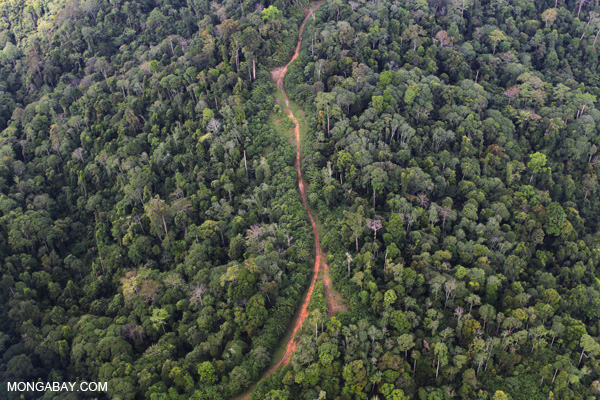- Researchers tested the independent impact of road noise on migratory birds, by setting up a “phantom road” in a forested region in southwest Idaho.
- The phantom road consisted of an array of speakers that played road noises at moderate volumes, simulating traffic on an actual road.
- In response to the noise, birds either left the phantom road areas, or they stayed, but at the cost of their health, the study found.

Traffic noise is just another inconvenience for many of us. But for wildlife, noise from honking, and zooming vehicles can often be an insidious threat: it can degrade habitats without leaving any physical evidence of change, warns a recent study published in the Proceedings of the National Academy of Sciences.
Road noise — even in moderate levels — pushes migrating birds away from their stopover habitats, researchers from Boise State University in Idaho found. Those that stay back become weak.
“I was initially surprised that even moderate road noise — comparable to a suburban setting — would have such a wide-ranging impact on migrating birds,” William Laurance, a professor at James Cook University in Cairns, Australia, who was not involved in the study, told Mongabay. “On reflection, however, I guess such migrators have to be hyper-vigilent about noise, as they’re constantly moving to new areas where unseen predators could be lurking.”
Threats from roads can be aplenty. To tease out the independent impact of traffic noise on birds from those of other threats, such as collisions, visual disturbance, and chemical pollution, the team set up an elaborate experiment. They created a “phantom road” — a road that was made out of noise alone.

Along half-kilometer forested section in Lucky Peak State Park in southwest Idaho, the researchers arranged an array of speakers that played road noises at moderate volumes, simulating traffic on an actual road.
The team also kept this phantom road away from any actual road noise by keeping the speakers’ locations very remote, Heidi Ware, lead author of the study, told Mongabay. This meant hiking and backpacking with 40 pounds of batteries a day to keep the phantom road running, she added.
In addition, the team had a comparable control site nearby that lacked any traffic noise. Then for two years, between 2012 and 2013, the researchers counted the number of migratory birds coming to the area, and assessed their body condition.
“Migration is an energetically stressful time,” Laurance writes in a commentary about the study. So any unpredictable noise in their stopover locations could potentially affect the time they spend being vigilant or feeding, ultimately affecting their health.
The team found that around 31 percent of the birds kept away from the phantom road. Of the remaining birds that stayed, most suffered loss of body mass.
The migratory MacGillivray’s warbler (Geothlypis tolmiei) was one such bird. The researchers found that while the bird did not leave the phantom road site despite the artificial road noise, its body condition worsened the most.
“If you were to count birds at the site you might infer that MacGillivray’s Warblers were tolerant of noise since they didn’t leave,” Ware said. “But the opposite is true. They showed the strongest decrease in body condition when the noise was on.”

This demonstrates that individuals may remain in an area with high levels of noise yet suffer significant costs, the authors write in the paper. So in response to the noise, birds either left the phantom road areas, or they stayed, but at the cost of their health, they add.
“I believe traffic noise is a big threat because it is invisible, hard to measure, and easy for humans to ignore, unlike other more obvious forms of pollution,” Ware said.
Human-made noise has penetrated most forests and oceans today. Only a few areas remain that are truly silent.
“There are still parts of the deep Amazon, Congo Basin, New Guinea, and Siberia where one wouldn’t hear much but an occasional airplane overhead,” Laurance said. “But those places are shrinking very rapidly. An indication of this is the growing number of parks and protected areas that are being polluted by human-caused sounds — everything from nearby traffic to the sounds of tourists and hikers.”

So how do we tackle this invisible threat from noise? Reducing noise levels on existing roads is one way out, Ware said. “This can be accomplished by changing speed limits, traffic volumes, or by using a quieter substrate such as rubberized asphalt.”
But for areas that do not have roads yet, we should keep new roads out, if possible, she added. “We should limit roads not only because of their traffic noise impacts, but also because roads naturally increase the human footprint and allow for other forms of habitat loss and degradation such as logging and mining in remote areas.”
Noise, as a pollutant and threat, does not impact birds and land-animals alone. Since noise travels better through water than air, and with huge increases in global shipping it’s clear that marine noise is a growing concern, Laurance said.
“Again, however, we need to know more about how marine noise might impact on the activity, movements, and populations of sensitive species such as whales, migratory fish, and other marine life,” he added.
Citations:
- Ware HE, McClure CJW, Carlisle JD, Barber JR (2015) A phantom road experiment reveals traffic noise is an invisible source of habitat degradation. Proc Natl Acad Sci USA, 10.1073/pnas.1504710112.
- Laurance WF (2015) Wildlife struggling in an increasingly noisy world. Proc Natl Acad Sci USA, 10.1073/pnas.1516050112
